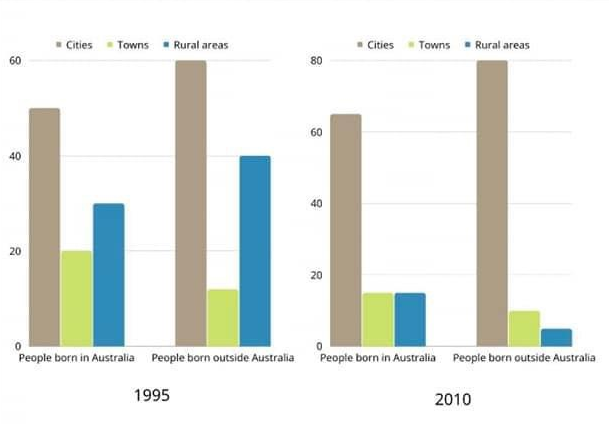[Bhumika G] Writing Practice Test 1020072
Task 1
You should spend about 20 minutes on this task.
The bar chart below describes some changes about the percentage of people were born in Australia and who were born outside Australia living in urban, rural and town between 1995 and 2010.
Summarise the information by selecting and reporting the main features and make comparisons where relevant.
You should write at least 150 words.

The bar graph shows the percentage of people born outside of Australia and born in Australia between the years 1995 and 2010 and the percentage ditribution shows the niche rates in the cities, towns and rural areas.
In the year 1995 we can see that the people born inside Australia preferred living in cities which shows approximately 45% of population which when compared to the people born outside Australia is more and goes about 63%. The people born inside Australia living in towns shows the variation from 20% which lowers down to 15% for the people born outside Australia. Coming down to the people who are residing in rural areas shows 25% for people born inside australia and this percentage increases to 40% for the people born outside Australia.
When we evaluate the year 2010 we can clearly see that the people who are born in thier home country are living in the cities showing the percentage of 64% which shoots up to almost 80% for the people born outside Australia. In 2010, people born inside Australia who live in towns and rural areas are the same which is about 17% which shows a gradual decrease for the people born outside Australia but living in towns which is 10% approximately and for rural areas it goes down to 5%.
So, collectively we can say that the percentage for both the years show a varying increase and decrease for both the groups of people residing in different areas of the country.
Task 2
You should spend about 40 minutes on this task.
Rich countries often give money to poorer countries, but it does not solve poverty. Therefore, developed countries should give other types of help to the poor countries rather than financial aid. To what extent do you agree or disagree?
You should write at least 250 words.
Rich and developed countries having a higher GDP share their share of profits to the poorer or underdevelpoed countries, in account they give out money to the underdeveloped countries.
Giving out financial profits to the poorer countries or a stable economy in making does not just require money but a good amount of exposure to all the aids which would collectively help in stabilizing the economy of that particular country. Money exposure is important but helping out a country in the green paper way is just one of the options which help out to an extent but not fully.
To deal with poverty and the baseline groups having problems in completing their daily needs does not just require the financial help but it could be more fertile if seen as a collective issue.
To solve this kind of problem the basic help which the developed countries can provide is by increasing the export and import buisness in the poor country in order to shoot up employment rates which are indirectly helping in developing the global market and hence the part of that poor country in it. One more solution that can be provided out to these poor countries is by increasing the tourism of that country, tourism is one the most basic means of increasing the local market and the increasing the economy of that country. This does not mean exploiting the natural environment of the resources infact quite opposite of it. Increasing the economy by using the local products made by the commoners in the particular place.
So, in conclusion we can say that only providing financial aids is not going to solve poverty or the condition of the underdeveloped country but rather increasing the employment rates with better tourism and local markets can help a lot.
Community’s feedback
Sorry! We couldn't find any contents.
Score Given by Community
Give a bandscoreLeaderboard:
| # | User | Score | Time | |
|---|---|---|---|---|
| Kento Nanami |  | 8.5 | 52:31 | |
| Nayef Alhajraf |  | 8.5 | 60:00 | |
| Ella Ruppo |  | 7.5 | 59:39 | |
| 4 | chengxi yu |  | 7.0 | 00:00 |
| 5 | avin chui |  | 7.0 | 59:11 |
| 6 | 癫 火 |  | 7.0 | 59:51 |
| 7 | Li Xuefeng |  | 6.5 | 03:46 |
| 8 | Chanisara Wongkongsang |  | 6.5 | 56:37 |
| 9 | Dan H |  | 6.0 | 50:41 |
| 10 | Carlo Di Giacomo |  | 6.0 | 60:00 |



